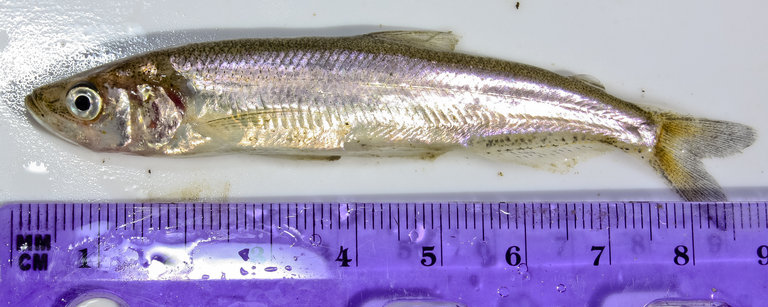Discovering longfin smelt in new habitats raises questions about long-term surveys
Longfin smelt use a greater diversity of spawning areas than previously known, complicating current methods of population assessments and projections for the highly endangered fish
August 29, 2019
For immediate release
Press Contact: Alison Mize, 202-833-8773 ext. 205; gro.asenull@nosilA
Author Contact: Levi Lewis; moc.liamgnull@ics.siwel

A small longfin smelt (Spirinchus thaleichthys) from Mare Island, CA is measured at about 9cm. Photo courtesy of Bill Stagnaro, CC BY-SA 3.0.
Longfin smelt – a four-inch-long silvery fish with a lifespan of only two years – once migrated in vast groups from open water to spawn in the less-salty waters of estuaries and wetlands dotting the Pacific coast of North America. But in the San Francisco Estuary – the largest estuary on the west coast – populations began to plummet in the 1980s.
Formerly so common that it supported a commercial fishery in San Francisco Bay, longfin are now placed on the California Endangered Species Act. Much like with their cousins – the better-known delta smelt – ecologists generally attribute their decline to the rapid expansion of dams and freshwater diversion projects for agricultural, industrial, and residential use in many Pacific watersheds in the early 1980s, as well as pollution and other human impacts that have detrimentally affected traditional fresh- or brackish-water spawning areas. Although longfin smelt can tolerate a wider range of salinity than delta smelt can, in some estuaries along the Pacific coast, longfin populations are estimated at a mere 1% of pre-1980 levels due to these environmental alterations.
However, while researching the impacts of formerly-industrial site restoration on aquatic ecosystems in the Coyote Creek watershed, a major tributary in the southern San Francisco Estuary, scientists with the University of California, Davis observed surprisingly high densities of reproductive adult smelt in the marshlands, which were not previously known to be heavily exploited by the species. The findings are reported in the Ecological Society of America’s journal Ecology.
“Prior to our study,” explains Levi Lewis, postdoctoral student at UC Davis and lead author of the paper, “fisheries biologists did not realize that smelt – an open-water forage fish – utilized and spawned in the highly modified, shallow, brackish tidal wetlands near Silicon Valley [in the southern portion of the Estuary].”
The discovery underscores how little is known not only of the species’ life history, but also of the degree to which the lack of information about how smelt use various habitats like marshlands, sand flats, or seagrass beds may hinder the effectiveness of current management, conservation, and restoration strategies in Pacific estuaries.
This information is lacking largely because much longfin data comes from long-term fishery surveys designed for other species such as striped bass. Striped bass live 30 years to the longfin’s two, so these surveys are already not a great fit to study longfin. Additionally, in the case of the San Francisco Estuary, these survey data are collected almost exclusively from deeper-water, upper Estuary and open-water bay habitats where the bigger fish are, which represent only a portion of the habitats that longfin might use in the Estuary.
As such, Lewis says that extending surveys of both larval and reproducing adult longfin into brackish wetland habitats throughout the Estuary is necessary for understanding their biology, and likely many other species’ as well. He adds that at present time, no surveys of larval or juvenile fishes are being conducted in these shallow wetlands, and consequently existing management and conservation approaches will need to be re-assessed and revised to reflect this additional habitat use, as will restoration efforts throughout the Estuary watershed.
“Longfin smelt need low-salinity water and shallow fresh or brackish wetland habitats to successfully reproduce,” says Lewis, “and they exhibit a strong positive population-level response to ‘wet’ years – that is, years of anomalously high precipitation – suggesting that higher freshwater outflow in rivers and creeks can benefit this species. Increased freshwater outflows throughout the Estuary, especially in dry years when low-salinity habitat is rare, may therefore greatly aid this species’ ability to weather unfavorable climate conditions.”
In addition to increasing freshwater flow rates, the authors emphasize that expanding restoration of tidal brackish wetland habitats along the many watersheds feeding into the Estuary system, and reducing agricultural and urban pollution, will benefit longfin smelt at all growth stages, further boosting smelt recovery.
Until researchers can gather more data about longfin life cycles, what sort of specific restoration would be most beneficial for them remains unknown. Lewis concludes, “Certain habitats may be overlooked simply because they have been under-sampled, or they are now rare or degraded. Comprehensive assessments of the distribution and niches of organisms are needed in order to fully understand their complex behaviors and habitat needs.”
Journal Article:
Authors:
Levi Lewis, Malte Willmes, Arthur Barros, Patrick Crain, and James Hobbes; University of California Davis, Wildlife, Fish, and Conservation Biology
Author Contact:
Levi Lewis moc.liamgnull@ics.siwel
###
The Ecological Society of America, founded in 1915, is the world’s largest community of professional ecologists and a trusted source of ecological knowledge, committed to advancing the understanding of life on Earth. The 10,000 member Society publishes five journals and a membership bulletin and broadly shares ecological information through policy, media outreach, and education initiatives. The Society’s Annual Meeting attracts 4,000-5,000 attendees and features the most recent advances in ecological science. Visit the ESA website at https://www.esa.org.